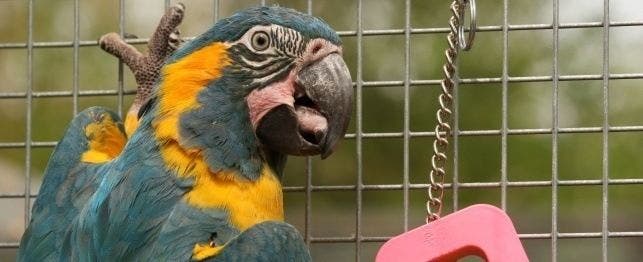
Keeping Your Aviary Healthy
Keeping your feathered friends happy and healthy takes a commitment of time and space, as well as education. How you manage your aviary, and whether you take a disorganized or well-defined approach to health management, will determine the health and well-being of your pets.
Look, Listen and Feel
From a medical standpoint, birds can be challenging. It is a bird’s natural instinct to hide any signs of disease to avoid being isolated by the flock. The community of the flock means protection, and birds will mask signs of illness to avoid losing that protection. For the pet owner, this behavior is significant because by the time you notice your bird is ill, he may have actually been sick for a long time. This will make medical care and treatment more difficult.
It should be part of your daily routine to observe each bird in your aviary. Look for any abnormal symptoms, no matter how subtle. Birds should be assessed for appetite, activity, feather abnormalities, labored breathing or increased respiratory rates. Very sick birds may appear to be fluffed up or they may have trouble perching. They may also be found at the bottom of the cage.
If your birds are social and can be easily handled, check routinely for body condition. Breast muscles should feel firm and rounded; loss of this prominent muscle mass means a problem with disease or nutrition. Check beaks and nails to see if any trimming needs to be done. Observe your bird’s droppings to make sure they appear normal, and do a direct inspection of the bird’s “vent” or cloaca to look for sign of diarrhea. Make yourself a daily checklist of these important health concerns and maintain a health journal. If a problem does arise, you will have specific information to give your veterinarian to help aid in a diagnosis and treatment plan.
Environment
Providing a safe and comfortable environment will go a long way to promote good health. Most aviculturists go to great lengths to provide similar conditions in the aviary that the birds would have in their natural habitat. Take this into consideration before choosing your birds. It may be best to restrict yourself to a particular species from one geographical region to simplify husbandry and environmental requirements. For example, the needs of passerine birds such as finches and canaries will be very different than those of psittacines. Each bird or breeding pair should have a nest box with an area that provides privacy. A hinged door on the back of the box can provide access for cleaning or observation. All surfaces should be made of materials that are easily cleaned and sanitized. This is essential for disease and parasite control. Natural wood should be restricted to types that are non-toxic, non-resin producing and pesticide free. Most natural wood products used are limited to perches, and must be replaced if significantly worn or contaminated.
An important part of your birds living quarters involves air flow and air quality. Avian diseases are easily spread and may be introduced to your aviary from outside sources or quarantined birds. Housing should be set up for laminar airflow, a system of positive pressure airflow that prevents outside air from coming into the aviary. Central air conditioning can recirculate air from contaminated areas into your bird’s environment.
Quarantine and Veterinary Care
Before any bird is introduced into the collection, a quarantine period should be imposed to acclimate your pet to his new surroundings and to ensure he is in good health. This area should be isolated and on a different air handling system than the established aviary. Birds should be observed for appetite, attitude, posture, diarrhea, trouble breathing, etc. A health check from a veterinarian that has experience with birds is essential. Problems are often discovered on routine physical exams that may require treatment or an extended period of quarantine. If you maintain a large number of birds, you may want to discuss with your veterinarian about making regularly scheduled housecalls to avoid the stress of transportation and possible injury. Emergencies will almost always require a trip to the veterinary hospital, so be prepared with a proper cage for transport.
Nutrition
To ignore a bird’s nutritional needs is to invite disaster. Many diseases that claim birds are linked to chronic malnutrition. A seed-only diet is inadequate for any species. Seeds are high in fat and lack many essential nutrients and adequate protein. Many aviaries offer seed only in small amounts and at specific feeding times. They are given in limited access as birds will develop a preference for them and ignore healthier items. There are many balanced foods formulated for different species. Fresh foods and breads or prepared biscuit should also be a part of your bird’s regular diet. Meat, milk and vitamin supplementation may also be needed. It will take a bit of research on your part to find the diet that is right for the birds you raise and find the foods they will accept. You should be prepared to provide fresh food on a daily basis, which means preparation time and frequent trips to the grocery store or produce stand.
These are but a few issues to consider when keeping an aviary. Before you acquire your birds, take the time to have all housing, supplies, diet, isolation and veterinary care in place before adding your birds. Obtain your birds from reputable sources that raise them with the same care and concern that you will give them. Birds can live a long time; some parrots can live well past 50 years of age, so truly these pets can be a lifetime commitment.